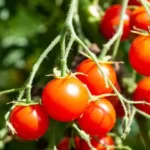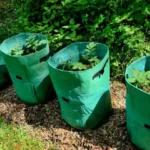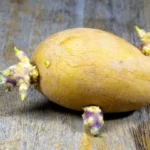Determining when to collect your homegrown spuds can be essential for a successful yield. You might wonder when to harvest potatoes in containers and how best to identify the perfect moment to dig up those tubers from your garden. Understanding the specific indicators of readiness and the ideal conditions for harvesting can greatly impact the quality and quantity of your potato harvest.
Potatoes grown in containers can be harvested when the plants are mature, and the potatoes have reached a desirable size. The exact timing can vary depending on the potato variety and growing conditions, but a few general guidelines can help determine when to harvest:
- Foliage Dieback: As the potatoes near maturity, the plant’s foliage will start to yellow and die back, a sign that the plant is diverting energy to the tubers underground.
- Flowering: Potato plants typically produce flowers before tubers are ready for harvest. However, while flowering can be an indicator, it’s not a definitive sign that the potatoes are ready for harvesting.
- Check The Size: Carefully dig around the base of the plant to check the size of the potatoes. Depending on the variety, they should be a decent size and fill out the soil around them within the container.
- Skin Firmness: The skins of mature potatoes should be firm and set. The potatoes may need more time to mature if the skins are still soft.
- Greening: Avoid exposing potatoes to direct sunlight, which can cause them to turn green and develop a bitter taste. Harvest them promptly once they reach maturity.
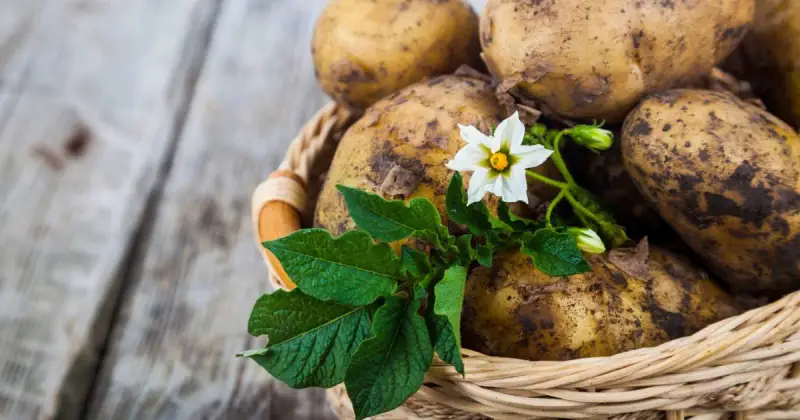
Although potato variety does play a part, it’s generally recommended to harvest potatoes in containers about 2-3 weeks after the foliage has died back to allow the skins to set and mature fully. However, there are several other vital signs your spuds are ready to be collected.
Humble Highlights
- Uncover the best timing to harvest your homegrown potatoes and the unique signs of potato maturity so you can ensure your spuds have developed their full flavor and texture, providing a better culinary experience.
- Discover the best ways to harvest container-grown potatoes to allow the plant to complete its growth cycle naturally so you can ensure that potatoes do not become overgrown – which can develop a tough texture and not store well.
- Cure your potatoes properly with these simple and straightforward tips, and they’ll be easier to store—providing a valuable food source for months after your last harvest!
Timing For Harvesting Potatoes
The timing for harvesting potatoes grown in containers depends on several factors, including the variety of potatoes, growing conditions, and your preference for potato size. Generally, potatoes can be harvested when the plants begin to yellow and die back, usually about 2-3 weeks after flowering, which is a critical sign that the potatoes have reached maturity and the plant is diverting energy to the tubers.
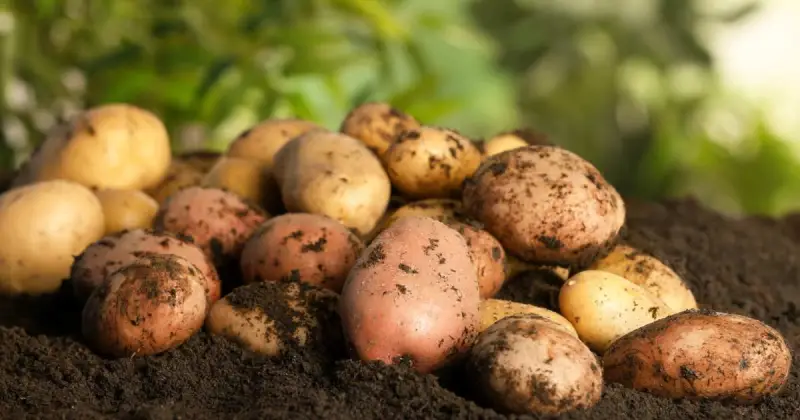
To check if the potatoes are ready, carefully dig around the base of the plant and feel for firm, mature potatoes. Avoid leaving the potatoes in the ground for too long, as they can quickly become waterlogged and begin to rot. 1
First early potatoes are ready for harvest within 60-105 days and should be harvested when small and thin-skinned. Second early potatoes fall between first early and maincrop varieties, and are typically ready for harvest within 95-120 days after planting. Maincrop potatoes, with a more extended growth period of 125-140 days, vary in storage time based on the specific variety and storage conditions.
To boost your chances for an excellent harvest, monitor the development of the tubers in containers and gradually harvest them based on their size and texture. Be sure to leave smaller potatoes to continue growing and reach their full size.
Understanding the growth timeline and characteristics of each potato variety will aid in determining the precise timing for harvesting in containers.
Signs Of Potato Maturity
To determine the readiness of potatoes for harvesting in containers, observe indicators such as yellowing and dying foliage on the plants. The foliage will gradually turn yellow and wither away as the potato plants mature.
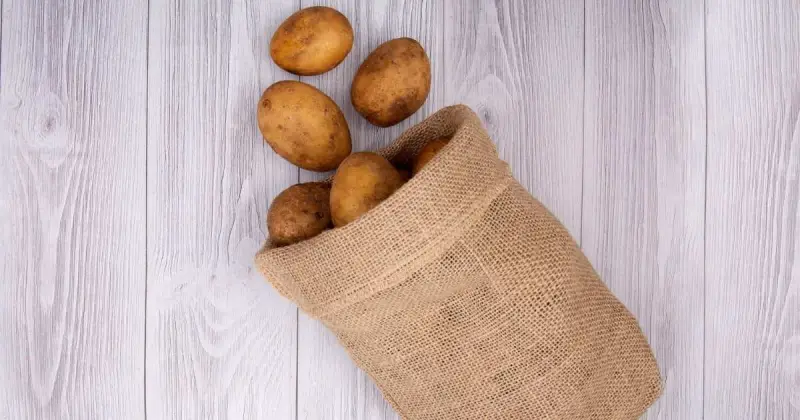
Additionally, check for developed tubers by gently squeezing them to determine their size and shape. When harvesting new potatoes from containers, look for small, thin-skinned tubers, typically around 55-65 days after planting.
If some tubers feel ready while others do not, harvest gradually to allow the remaining potatoes to continue maturing. By paying attention to these signs of maturity and following these guidelines, you can secure a successful harvest of flavorful and well-developed potatoes from your containers. 2
Another tell-tale sign of potato maturity is the development of a russeting or net-like pattern on the outer skin of some potato varieties. This russeting is more common in certain heirloom and specialty potato varieties and is not always present in all types of potatoes.
However, when it does occur, it can be a visual cue that the potatoes are mature and ready to harvest. Russeting is caused by the formation of suberin, a waxy substance, in the potato skin, indicating that the tubers have reached their full size and are ready for harvest.
Harvesting Process For Potatoes
When harvesting potatoes grown in containers, gently digging out the tubers is recommended to prevent damage during extraction. Harvest these potatoes after the plants have flowered and the foliage has turned yellow, signaling that the tubers are likely ready. Cease watering the plants when the stems begin to yellow, indicating that the potatoes have reached maturity.
When it’s time to harvest, carefully excavate the potatoes from the container to avoid bruising or cutting them. Another standard method with home gardeners is to tip the container onto a tarp or wheelbarrow and sift through the soil to collect the tubers.
Once harvested, clean the potatoes and let them cure in a cool, dark place for about two weeks. After curing, store the potatoes in a well-ventilated location to maintain their freshness. 3
Knowing when to harvest your homegrown spuds is the final step to cultivating delicious tubers. And even though there are some differences in harvesting certain potato varieties, several steps are still the same. Check out the backyard gardener in the video below, which details how and when he collects his potato crop and how his step-by-step process can help you!
Curing Potatoes After Harvest
During the post-harvest period, it’s essential to cure potatoes in a cool and dark environment to enhance their skin resilience and extend shelf life. Curing involves storing harvested potatoes in a cool, dark place with high humidity for about 1-2 weeks. This process allows the potatoes to toughen their exterior skin, helping to heal any minor cuts or bruises acquired during harvesting.
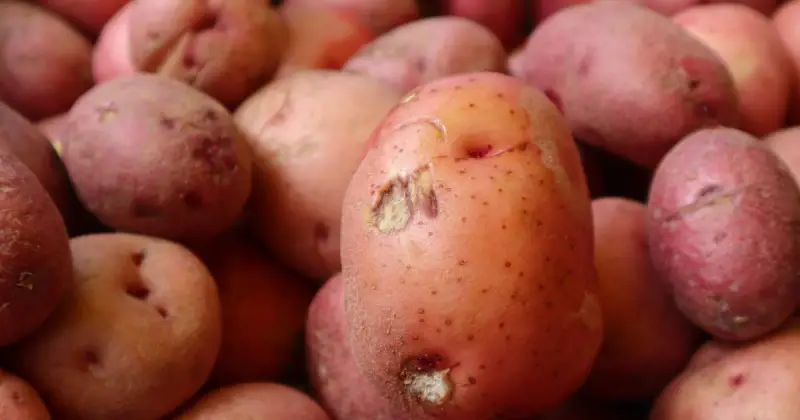
By developing and strengthening their protective layer, potatoes are less likely to rot or sprout prematurely, so long as they are appropriately stored. Properly storing your potatoes improves their shelf life and boasts enhanced flavor profiles. 4
After the curing process, storing the potatoes in a cool, dark, and well-ventilated area with high humidity is essential to maintain their quality. This meticulous approach to post-harvest curing sets the foundation for successful long-term storage of your harvested potatoes.
A lesser-known fact about curing potatoes is that it can help improve their nutritional profile. During the curing process, some of the potato’s starches are converted into more easily digestible forms, such as sugars, making the potatoes a better source of quick energy.
Additionally, curing can help preserve the potatoes’ vitamin and mineral content, ensuring they retain their nutritional value for longer periods. Properly cured potatoes can be a nutritious addition to your diet, providing essential vitamins, minerals, and energy.
Proper Storage Of Harvested Potatoes
To best preserve harvested potatoes, store them in a cool, dark, well-ventilated area with high humidity to prevent sprouting and spoilage. Check the stored potatoes regularly for signs of damage or rot, and promptly remove any affected tubers to prevent the spread of spoilage. The critical storage temperature for potatoes is between 40 and 45 degrees Fahrenheit, as this range helps maintain quality and freshness over an extended period.
Curing harvested potatoes is vital to toughening the skin and extending their storage life. To allow for curing, place the harvested potatoes in a dark, cool location for 1-2 weeks before transferring them to long-term storage. Proper storage conditions can help stored potatoes retain quality for up to 6-8 months, greatly prolonging their shelf life. 5

Conclusion
Timing is essential when harvesting potatoes grown in containers. You can increase your chances of a successful harvest by observing the signs of maturity, such as yellowing foliage and feeling for developed tubers.
Remember to gently dig out the tubers to prevent damage and consider curing and storing them correctly for long-term use. Following these guidelines will help you maximize the yield and quality of your container-grown potatoes.
What variety of potatoes do you cultivate at home, and when do you harvest them? Take a moment and drop us a line in the comment section below and let us know what specific signs you look for to know your potatoes are ready to be harvested!
SOURCES
- Springer – Harvesting Potatoes With Minimum Damage
- University Of Nebraska-Lincoln, Institute Of Agriculture And Natural Resources – Potatoes: Harvesting & Storage
- Michigan State University, Extension – Homegrown Potatoes Tell You When To Harvest Them
- Ohio State University, Extension Service – Tips On Keeping Harvested Potatoes Fresh
- Iowa State University, Extension And Outreach – Yard And Garden: Growing And Harvesting Potatoes




